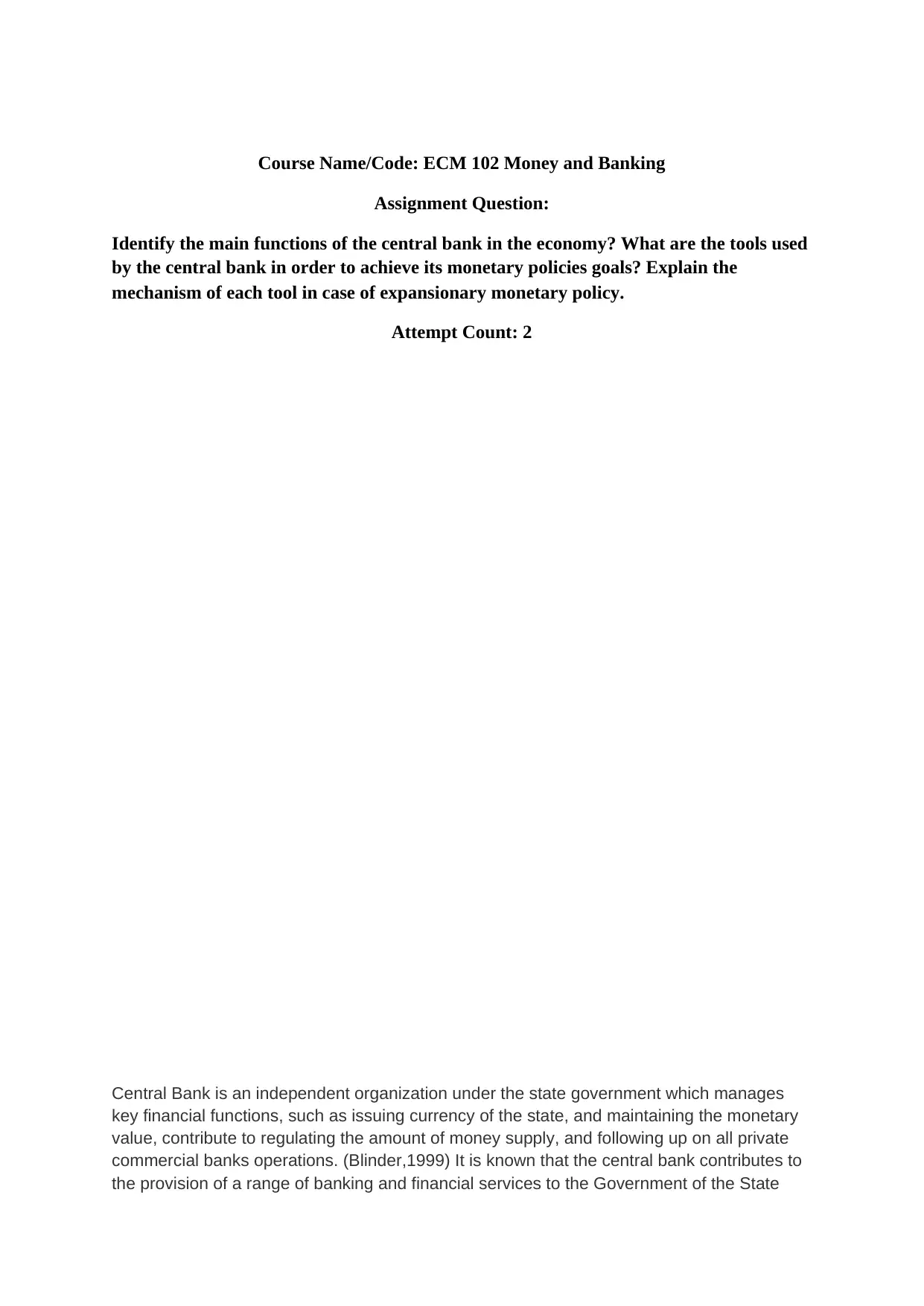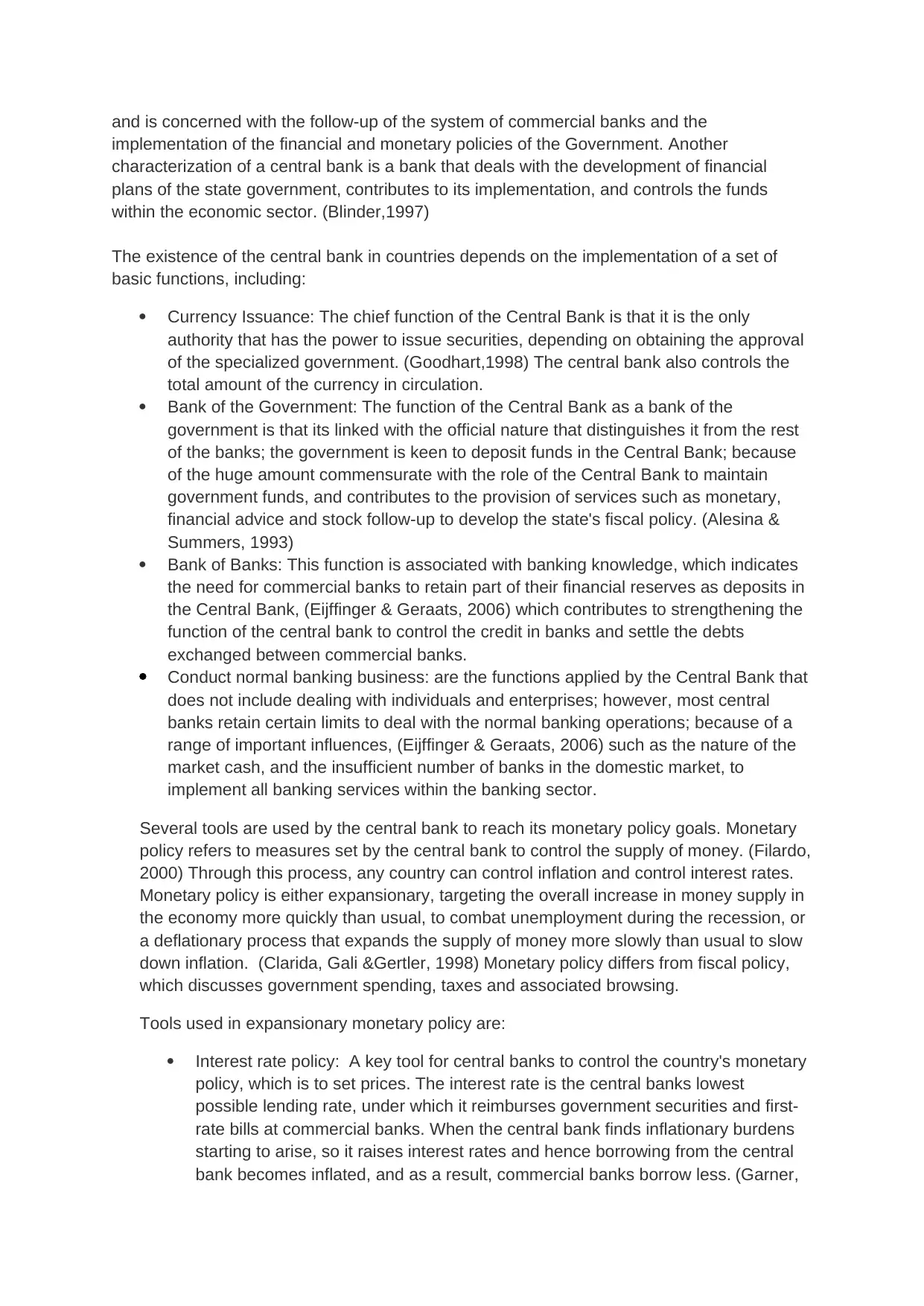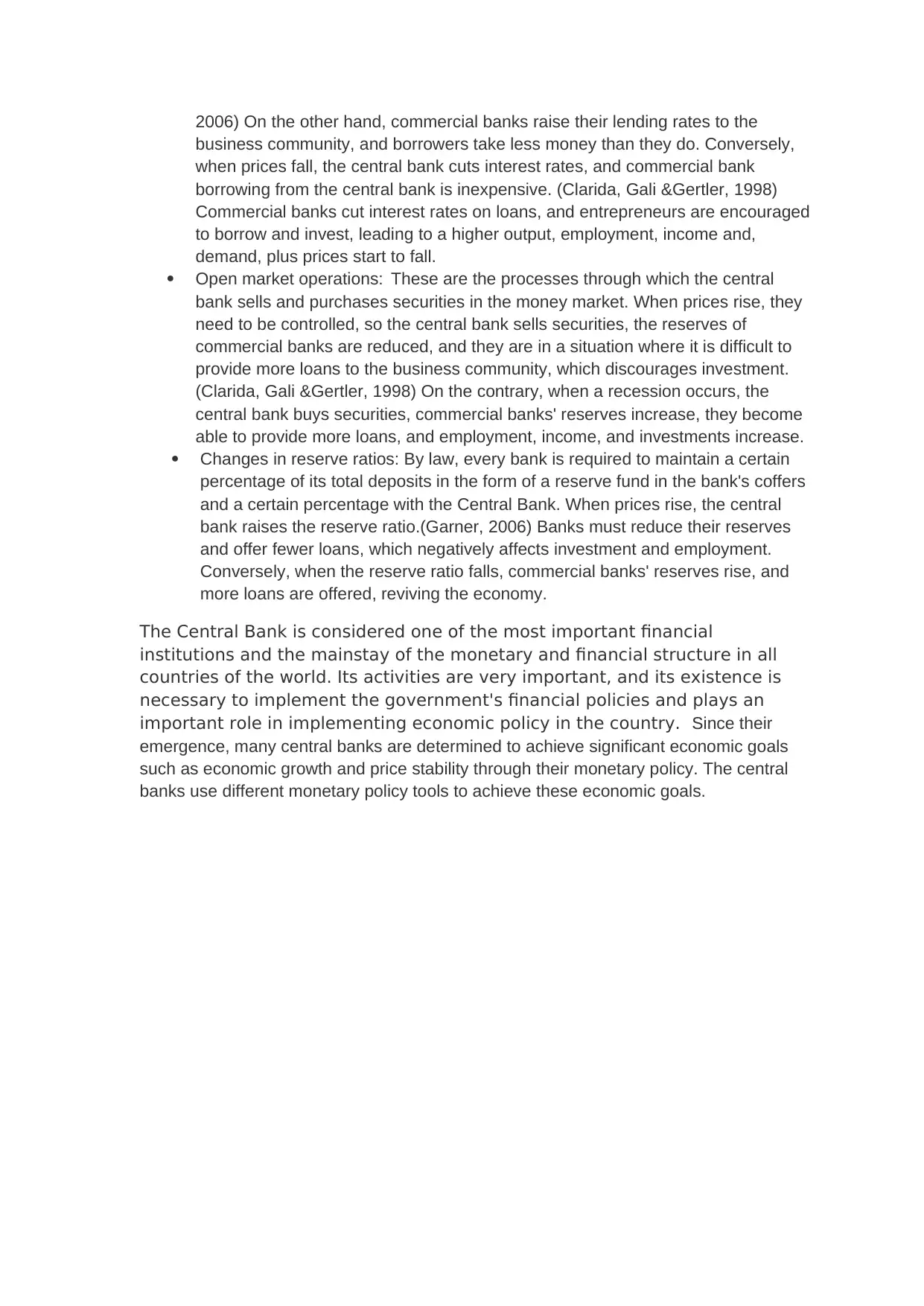ECM 102: Central Bank Functions, Monetary Policies, and Tools
VerifiedAdded on 2020/11/13
|4
|1149
|209
Homework Assignment
AI Summary
This assignment delves into the core functions of a central bank, which include currency issuance, acting as the government's and banks' bank, and conducting normal banking business. It highlights the central bank's role in managing the money supply and achieving economic goals like price stability and growth. The assignment then examines the tools used to implement monetary policy, particularly focusing on expansionary monetary policy. These tools include interest rate policy, open market operations, and changes in reserve ratios. The document explains the mechanisms of each tool, detailing how they influence borrowing, lending, investment, and overall economic activity during expansionary monetary policy. The assignment emphasizes the central bank's significance as a key financial institution that implements government financial policies and plays a crucial role in economic policy implementation.

Course Name/Code: ECM 102 Money and Banking
Assignment Question:
Identify the main functions of the central bank in the economy? What are the tools used
by the central bank in order to achieve its monetary policies goals? Explain the
mechanism of each tool in case of expansionary monetary policy.
Attempt Count: 2
Central Bank is an independent organization under the state government which manages
key financial functions, such as issuing currency of the state, and maintaining the monetary
value, contribute to regulating the amount of money supply, and following up on all private
commercial banks operations. (Blinder,1999) It is known that the central bank contributes to
the provision of a range of banking and financial services to the Government of the State
Assignment Question:
Identify the main functions of the central bank in the economy? What are the tools used
by the central bank in order to achieve its monetary policies goals? Explain the
mechanism of each tool in case of expansionary monetary policy.
Attempt Count: 2
Central Bank is an independent organization under the state government which manages
key financial functions, such as issuing currency of the state, and maintaining the monetary
value, contribute to regulating the amount of money supply, and following up on all private
commercial banks operations. (Blinder,1999) It is known that the central bank contributes to
the provision of a range of banking and financial services to the Government of the State
Paraphrase This Document
Need a fresh take? Get an instant paraphrase of this document with our AI Paraphraser

and is concerned with the follow-up of the system of commercial banks and the
implementation of the financial and monetary policies of the Government. Another
characterization of a central bank is a bank that deals with the development of financial
plans of the state government, contributes to its implementation, and controls the funds
within the economic sector. (Blinder,1997)
The existence of the central bank in countries depends on the implementation of a set of
basic functions, including:
Currency Issuance: The chief function of the Central Bank is that it is the only
authority that has the power to issue securities, depending on obtaining the approval
of the specialized government. (Goodhart,1998) The central bank also controls the
total amount of the currency in circulation.
Bank of the Government: The function of the Central Bank as a bank of the
government is that its linked with the official nature that distinguishes it from the rest
of the banks; the government is keen to deposit funds in the Central Bank; because
of the huge amount commensurate with the role of the Central Bank to maintain
government funds, and contributes to the provision of services such as monetary,
financial advice and stock follow-up to develop the state's fiscal policy. (Alesina &
Summers, 1993)
Bank of Banks: This function is associated with banking knowledge, which indicates
the need for commercial banks to retain part of their financial reserves as deposits in
the Central Bank, (Eijffinger & Geraats, 2006) which contributes to strengthening the
function of the central bank to control the credit in banks and settle the debts
exchanged between commercial banks.
Conduct normal banking business: are the functions applied by the Central Bank that
does not include dealing with individuals and enterprises; however, most central
banks retain certain limits to deal with the normal banking operations; because of a
range of important influences, (Eijffinger & Geraats, 2006) such as the nature of the
market cash, and the insufficient number of banks in the domestic market, to
implement all banking services within the banking sector.
Several tools are used by the central bank to reach its monetary policy goals. Monetary
policy refers to measures set by the central bank to control the supply of money. (Filardo,
2000) Through this process, any country can control inflation and control interest rates.
Monetary policy is either expansionary, targeting the overall increase in money supply in
the economy more quickly than usual, to combat unemployment during the recession, or
a deflationary process that expands the supply of money more slowly than usual to slow
down inflation. (Clarida, Gali &Gertler, 1998) Monetary policy differs from fiscal policy,
which discusses government spending, taxes and associated browsing.
Tools used in expansionary monetary policy are:
Interest rate policy: A key tool for central banks to control the country's monetary
policy, which is to set prices. The interest rate is the central banks lowest
possible lending rate, under which it reimburses government securities and first-
rate bills at commercial banks. When the central bank finds inflationary burdens
starting to arise, so it raises interest rates and hence borrowing from the central
bank becomes inflated, and as a result, commercial banks borrow less. (Garner,
implementation of the financial and monetary policies of the Government. Another
characterization of a central bank is a bank that deals with the development of financial
plans of the state government, contributes to its implementation, and controls the funds
within the economic sector. (Blinder,1997)
The existence of the central bank in countries depends on the implementation of a set of
basic functions, including:
Currency Issuance: The chief function of the Central Bank is that it is the only
authority that has the power to issue securities, depending on obtaining the approval
of the specialized government. (Goodhart,1998) The central bank also controls the
total amount of the currency in circulation.
Bank of the Government: The function of the Central Bank as a bank of the
government is that its linked with the official nature that distinguishes it from the rest
of the banks; the government is keen to deposit funds in the Central Bank; because
of the huge amount commensurate with the role of the Central Bank to maintain
government funds, and contributes to the provision of services such as monetary,
financial advice and stock follow-up to develop the state's fiscal policy. (Alesina &
Summers, 1993)
Bank of Banks: This function is associated with banking knowledge, which indicates
the need for commercial banks to retain part of their financial reserves as deposits in
the Central Bank, (Eijffinger & Geraats, 2006) which contributes to strengthening the
function of the central bank to control the credit in banks and settle the debts
exchanged between commercial banks.
Conduct normal banking business: are the functions applied by the Central Bank that
does not include dealing with individuals and enterprises; however, most central
banks retain certain limits to deal with the normal banking operations; because of a
range of important influences, (Eijffinger & Geraats, 2006) such as the nature of the
market cash, and the insufficient number of banks in the domestic market, to
implement all banking services within the banking sector.
Several tools are used by the central bank to reach its monetary policy goals. Monetary
policy refers to measures set by the central bank to control the supply of money. (Filardo,
2000) Through this process, any country can control inflation and control interest rates.
Monetary policy is either expansionary, targeting the overall increase in money supply in
the economy more quickly than usual, to combat unemployment during the recession, or
a deflationary process that expands the supply of money more slowly than usual to slow
down inflation. (Clarida, Gali &Gertler, 1998) Monetary policy differs from fiscal policy,
which discusses government spending, taxes and associated browsing.
Tools used in expansionary monetary policy are:
Interest rate policy: A key tool for central banks to control the country's monetary
policy, which is to set prices. The interest rate is the central banks lowest
possible lending rate, under which it reimburses government securities and first-
rate bills at commercial banks. When the central bank finds inflationary burdens
starting to arise, so it raises interest rates and hence borrowing from the central
bank becomes inflated, and as a result, commercial banks borrow less. (Garner,

2006) On the other hand, commercial banks raise their lending rates to the
business community, and borrowers take less money than they do. Conversely,
when prices fall, the central bank cuts interest rates, and commercial bank
borrowing from the central bank is inexpensive. (Clarida, Gali &Gertler, 1998)
Commercial banks cut interest rates on loans, and entrepreneurs are encouraged
to borrow and invest, leading to a higher output, employment, income and,
demand, plus prices start to fall.
Open market operations: These are the processes through which the central
bank sells and purchases securities in the money market. When prices rise, they
need to be controlled, so the central bank sells securities, the reserves of
commercial banks are reduced, and they are in a situation where it is difficult to
provide more loans to the business community, which discourages investment.
(Clarida, Gali &Gertler, 1998) On the contrary, when a recession occurs, the
central bank buys securities, commercial banks' reserves increase, they become
able to provide more loans, and employment, income, and investments increase.
Changes in reserve ratios: By law, every bank is required to maintain a certain
percentage of its total deposits in the form of a reserve fund in the bank's coffers
and a certain percentage with the Central Bank. When prices rise, the central
bank raises the reserve ratio.(Garner, 2006) Banks must reduce their reserves
and offer fewer loans, which negatively affects investment and employment.
Conversely, when the reserve ratio falls, commercial banks' reserves rise, and
more loans are offered, reviving the economy.
The Central Bank is considered one of the most important financial
institutions and the mainstay of the monetary and financial structure in all
countries of the world. Its activities are very important, and its existence is
necessary to implement the government's financial policies and plays an
important role in implementing economic policy in the country. Since their
emergence, many central banks are determined to achieve significant economic goals
such as economic growth and price stability through their monetary policy. The central
banks use different monetary policy tools to achieve these economic goals.
business community, and borrowers take less money than they do. Conversely,
when prices fall, the central bank cuts interest rates, and commercial bank
borrowing from the central bank is inexpensive. (Clarida, Gali &Gertler, 1998)
Commercial banks cut interest rates on loans, and entrepreneurs are encouraged
to borrow and invest, leading to a higher output, employment, income and,
demand, plus prices start to fall.
Open market operations: These are the processes through which the central
bank sells and purchases securities in the money market. When prices rise, they
need to be controlled, so the central bank sells securities, the reserves of
commercial banks are reduced, and they are in a situation where it is difficult to
provide more loans to the business community, which discourages investment.
(Clarida, Gali &Gertler, 1998) On the contrary, when a recession occurs, the
central bank buys securities, commercial banks' reserves increase, they become
able to provide more loans, and employment, income, and investments increase.
Changes in reserve ratios: By law, every bank is required to maintain a certain
percentage of its total deposits in the form of a reserve fund in the bank's coffers
and a certain percentage with the Central Bank. When prices rise, the central
bank raises the reserve ratio.(Garner, 2006) Banks must reduce their reserves
and offer fewer loans, which negatively affects investment and employment.
Conversely, when the reserve ratio falls, commercial banks' reserves rise, and
more loans are offered, reviving the economy.
The Central Bank is considered one of the most important financial
institutions and the mainstay of the monetary and financial structure in all
countries of the world. Its activities are very important, and its existence is
necessary to implement the government's financial policies and plays an
important role in implementing economic policy in the country. Since their
emergence, many central banks are determined to achieve significant economic goals
such as economic growth and price stability through their monetary policy. The central
banks use different monetary policy tools to achieve these economic goals.
⊘ This is a preview!⊘
Do you want full access?
Subscribe today to unlock all pages.

Trusted by 1+ million students worldwide

1 out of 4
Related Documents
Your All-in-One AI-Powered Toolkit for Academic Success.
+13062052269
info@desklib.com
Available 24*7 on WhatsApp / Email
![[object Object]](/_next/static/media/star-bottom.7253800d.svg)
Unlock your academic potential
Copyright © 2020–2025 A2Z Services. All Rights Reserved. Developed and managed by ZUCOL.





